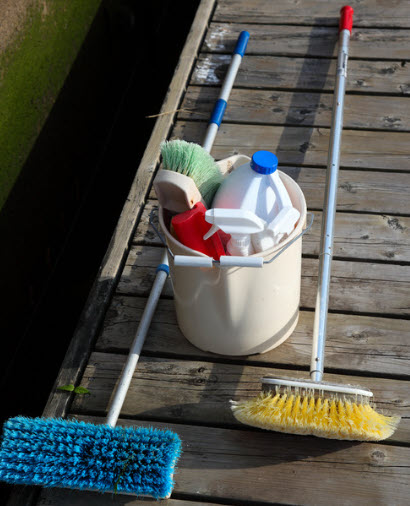Welcome to todays post where I’ll be sharing some actionable steps on how to properly clean and polish a fibreglass boat.
Ah, the joy of cruising on a sparkling boat! The sun glinting off the gelcoat, the envious stares from fellow boaters – it’s a feeling unlike any other. But, let’s be real, that showroom shine fades over time. The relentless sun, saltwater spray, and everyday grime can leave your once-proud vessel looking a bit, well, weathered.
Here’s the good news: with a little elbow grease and the right knowledge, you can transform your boat back into a head-turning masterpiece. This guide will be your roadmap to achieving that coveted shine, but more importantly, it will show you why regular cleaning and polishing are essential for the long-term health of your boat.
Table of Contents
The Importance of a Gleaming Gelcoat
Think of your boat’s shiny gelcoat as its superhero suit. It’s the first line of defense against the harsh elements. Regular cleaning and polishing are like putting on sunscreen and bug spray for your vessel. Here’s why it matters:
- Shields from the Sun’s Fury: Prolonged sun exposure can wreak havoc on the gelcoat, causing it to fade, crack, and lose its luster. Polishing removes a layer of oxidation (that white, chalky film) caused by UV rays, restoring the gelcoat’s shine and protective properties.
- Keeps Your Boat Looking Ship-Shape: Let’s face it, a clean and polished boat is a thing of beauty. It reflects pride of ownership and makes those cruising days even more enjoyable.
- Makes Cleaning a Breeze (Literally): A smooth, polished surface repels dirt and grime buildup, making future cleaning sessions a breeze. Imagine the difference between washing a dusty car and a freshly waxed one – that’s the power of polishing!
Regular Maintenance: Your Boat’s Fountain of Youth
Just like a healthy diet and exercise keep you feeling young, regular cleaning and polishing extend the life of your boat. Here’s how:
- Prevents Costly Repairs: Neglected gelcoat cracks and fades, leading to more expensive repairs down the road. Regular maintenance catches problems early and keeps your boat in tip-top shape.
- Maintains Resale Value: A well-maintained boat with a gleaming gelcoat will fetch a higher price when it’s time to sell. Think of it as an investment in your boat’s future.
- Pride of Ownership: There’s a certain satisfaction that comes with taking care of your prized possession. A clean and polished boat reflects your dedication and adds to the enjoyment of owning it.
Understanding Fiberglass: Your Boat’s Foundation
Fiberglass is the workhorse material of the boating world, and for good reason. It’s a champion when it comes to boat construction thanks to its winning combination of:
- Strength: Fiberglass boasts incredible strength-to-weight ratio. It can withstand the bumps and bruises of navigating the water, making it a reliable choice for boats of all sizes.
- Lightweight: Compared to traditional materials like wood or steel, fiberglass is a featherweight. This translates to better fuel efficiency and improved overall performance.
- Corrosion Resistance: Saltwater is the enemy of many boat materials, but fiberglass laughs in the face of its corrosive tendencies.
However, even superheroes have weaknesses. While fiberglass offers numerous benefits, it’s not invincible when it comes to maintaining its pristine condition. Here’s what you need to know:
The Achilles’ Heel of Fiberglass: Dirt, Grime, and Oxidation
The very properties that make fiberglass great for boats also contribute to its susceptibility to some enemies:
- Dirt and Grime: The rough texture of unpolished fiberglass acts like a magnet for dirt, grime, and even water stains. Over time, this buildup can dull the shine and make cleaning more challenging.
- Oxidation: The relentless sun is every boat owner’s nemesis. Ultraviolet rays break down the gelcoat, causing it to oxidize. This is what creates that white, chalky film – the telltale sign of a neglected boat.
The Right Tools for the Job: Why Technique Matters
Fiberglass is a resilient material, but it requires a gentle touch when it comes to cleaning and polishing. Harsh chemicals or abrasive tools can damage the gelcoat, leaving permanent scratches or dulling the finish leaving the surface in need of professional attention.
Here’s where using the right techniques and products becomes crucial. By following the proper steps with appropriate cleaning solutions and gentle polishing compounds, you can remove dirt, grime, and oxidation without harming the gelcoat. Think of it as giving your boat a spa treatment, restoring its shine and protecting it for years to come.
Materials and Equipment: Your Boat Cleaning Arsenal

Now that we understand the importance of cleaning and polishing, let’s gather the tools you’ll need to transform your boat from weathered to wonderful. Think of this as your boat cleaning arsenal:
Essential Weapons:
- Cleaning Solutions: Ditch the dish soap! You’ll need a marine-grade cleaner specifically formulated for fiberglass. These cleaners are gentle enough not to damage the gelcoat while effectively removing dirt, grime, and stains.
- Polishing Compounds: These come in varying levels of abrasiveness. For mild oxidation, an all-purpose polish will suffice. For more stubborn cases, a cutting compound might be necessary. Pro tip: Consult a marine store or a professional detailer to choose the right polish for your boat’s needs.
- Microfiber Towels: These are your gentle giants when it comes to drying and buffing the boat. Microfiber cloths are super absorbent and won’t leave any scratches on the polished surface.
- Soft-Bristle Brushes: For tougher grime, a soft-bristled brush is your friend. However, avoid anything too stiff that could scratch the gelcoat. Think of a gentle touch here!
- Protective Gear: Safety first, mateys! Don a pair of gloves to shield your hands from cleaning solutions and polishing compounds. Goggles are also a good idea to protect your eyes from splashes.
Bonus Gear:
- Bucket: A sturdy bucket for holding your cleaning solution and rinsing water.
- Sponge: A good quality marine sponge can be helpful for applying cleaning solutions.
- Polishing Pad: For larger boats or for those who want to save some elbow grease, a polishing pad attached to a drill or polisher can make things easier. Just be sure to use it on low speed with a gentle touch.
- Boat Wash: For a quick cleaning between deep cleans, a good boat wash can help remove light dirt and grime.
Remember: Using the right tools and products is key to achieving a flawless finish without damaging your boat.
Prepping Your Boat for a Sparkling Transformation
Before we dive into the deep clean, let’s get your boat prepped for its transformation. Think of it as prepping a canvas for a masterpiece! Here are the key steps to take:
1. Banish the Debris:
First things first, clear the deck (literally!). Sweep away any leaves, twigs, or other hitchhikers that might have landed on your boat. This will make the cleaning process smoother and prevent unwanted scratches.
2. A Refreshing Rinse:
Next, give your boat a thorough rinse with fresh water. This removes surface dirt, dust, and any lingering salt residue (especially important for saltwater boaters). Saltwater can leave a film that attracts dirt and grime, so getting rid of it is crucial. Use a hose with a gentle spray to avoid blasting anything important overboard.
3. Identifying Your Enemy:
Now, it’s time to become a boat detective! Take a good, close look at the surface and identify any areas that require special attention. Here are some common culprits to watch for:
- Stubborn Stains: Bird droppings, fish blood, or engine exhaust stains might need a targeted cleaning solution before the general cleaning process.
- Heavy Oxidation: That white, chalky film is a telltale sign of advanced oxidation. These areas might require a stronger polishing compound.
- Waterline Scum: The waterline is the area where the boat meets the water. Over time, mineral deposits and grime can build up here, creating a visible line. Specific cleaning solutions can help tackle this problem.
By identifying these problem areas ahead of time, you can tailor your cleaning approach and ensure a more thorough job.
Cleaning Process: Unveiling the Hidden Shine

Now that your boat is prepped and your cleaning arsenal is at the ready, it’s time for the fun part (well, maybe not the most fun, but definitely rewarding!). Here’s a step-by-step guide to cleaning your fiberglass boat:
1. Lather Up with Love (the Right Kind of Love):
Grab your trusty bottle of marine-grade cleaner and dilute it with water according to the manufacturer’s instructions. Using a clean sponge or a spray bottle (depending on the cleaner), apply the solution liberally to the entire boat surface.
Pro Tip: Work in manageable sections to avoid the cleaner drying before you have a chance to rinse it off.
2. Banish the Grime with Gentle Force:
Now, it’s time to tackle those stubborn dirt and grime patches. Equip yourself with your soft-bristled brush and gently scrub the affected areas in a circular motion. Remember, be gentle! Using excessive force or a stiff brush can scratch the gelcoat.
3. Rinse and Repeat (But Not the Coffee):
Once you’ve scrubbed the entire boat, it’s time to rinse everything off thoroughly. Use a strong stream of fresh water to remove all the cleaning solution and loosened dirt. Inspect the surface closely to ensure there’s no soap residue remaining.
4. Embrace the Power of Microfiber:
Here’s where your microfiber towels become superheroes! Use them to meticulously dry the entire boat surface. Microfiber cloths are super absorbent and won’t leave any streaks or scratches behind. Remember, a completely dry surface is crucial to prevent water spots and ensure a flawless polish later.
Bonus Tip: For stubborn water spots, you can use a white vinegar solution (50% vinegar, 50% water) to remove them before drying. Just be sure to rinse the vinegar solution off completely with fresh water afterwards.
Polishing Process: Bringing Back the Bling
Now that your boat is sparkling clean, it’s time to take it to the next level – the polishing stage! Polishing removes oxidation, restores shine, and adds a protective layer to your boat’s gelcoat. Here’s how to achieve that showroom shine:
1. Choose Your Weapon Wisely:
Remember those different polishes we talked about earlier? Here’s where they come into play. For mild oxidation, an all-purpose polish will work wonders. For heavier cases, a cutting compound might be necessary. Always consult the manufacturer’s instructions on the polish or a marine professional to choose the right product for your boat’s needs.
2. Apply with Precision:
Pour a small amount of polish onto a clean, damp microfiber towel. Work in small sections at a time, applying the polish in a thin, even layer to the surface. Less is more here – you don’t want to overdo it.
3. Unleash the Power of Buffing (or Your Arm):
There are two ways to buff the polish:
- By Hand: Using a clean microfiber towel, buff the polish in a circular motion with moderate pressure. Keep buffing until the polish turns clear and the surface gains a noticeable shine.
- With a Power Tool (Optional): For larger boats or for those who want to save some elbow grease, a polishing pad attached to a drill or polisher can be a helpful tool. Use a low speed setting and a gentle touch to avoid damaging the gelcoat. Always follow the manufacturer’s instructions for the specific polishing pad you’re using.
4. Wipe Away the Excess:
Once you’ve buffed the entire section, use a clean microfiber towel to wipe away any excess polish residue. This will ensure a flawless, streak-free finish.
Pro Tip: Buff and wipe one section at a time to prevent the polish from drying before you have a chance to remove it.
Final Touches and Maintenance Tips: Keeping Your Boat Looking Shipshape

You’ve come a long way, matey! Your boat is now clean, polished, and gleaming in the sun. But before you set sail and show off your handiwork, there are a few final touches and some important maintenance tips to keep your boat looking its best for years to come.
1. A Final Inspection:
Take a good look at your boat from all angles. Run your hand over the surface to check for any missed spots or imperfections. If you find any, address them with a touch-up of polish or cleaning solution.
2. Sealing the Deal with Wax:
Think of wax as sunscreen for your boat. A good quality marine-grade wax adds an extra layer of protection against UV rays, saltwater, and environmental damage. It also helps maintain the shine and repels dirt and grime, making future cleaning sessions easier. Apply the wax following the manufacturer’s instructions, typically in a thin, even coat, and buff it off with a clean microfiber towel.
3. Maintenance is Key:
Just like a healthy diet keeps you looking your best, regular maintenance is crucial for keeping your boat looking shipshape. Here are some simple tips to follow:
- Rinse after Every Use: Especially after saltwater use, give your boat a quick rinse with fresh water to remove any salt residue that can attract dirt and grime.
- Cover Up When Not in Use: When your boat’s not in use, protect it from the harsh sun and elements with a good quality boat cover.
- Regular Washes: In between deep cleaning and polishing sessions, give your boat a quick wash with a marine-grade cleaner to remove surface dirt and grime buildup.
- Touch-Up Polishing: If you notice any minor oxidation or loss of shine, a light touch-up polish can restore the luster.
By following these simple maintenance tips, you can extend the life of your boat’s gelcoat and keep it looking like a head-turning masterpiece for years to come!
Conclusion: A Sparkling Legacy for Your Boat
There you have it! The secrets to a sparkling clean and beautifully polished fiberglass boat are now yours. Remember, proper cleaning and polishing aren’t just about aesthetics; they’re essential for protecting your boat’s gelcoat and extending its lifespan.
Think of it as an investment in your pride and joy. A well-maintained boat not only looks fantastic, but it also retains its value and provides years of enjoyment on the water.
So, what are you waiting for? Grab your cleaning supplies, follow the steps outlined in this guide, and get ready to transform your boat from weathered to wonderful.
Regular maintenance is key! By incorporating the simple cleaning and polishing techniques you’ve learned here into your routine, you’ll ensure your boat continues to be the envy of the marina.
Do you have any questions or tips of your own for cleaning and polishing fiberglass boats? Share your experiences and let’s keep the conversation flowing in the comments below! After all, the boating community thrives on sharing knowledge and helping each other keep our vessels shipshape.
Now, go forth and conquer the waves with a boat that shines as brightly as your smile!
FAQ
How do I make my fiberglass boat shine again?
Clean the boat with a marine-grade cleaner, then polish it with a fiberglass polish to remove oxidation and restore shine. Finally, apply a coat of marine wax for extra protection.
What’s the best way to clean a fiberglass boat?
Use a marine-grade cleaner and soft-bristle brushes. Rinse thoroughly with fresh water and dry with microfiber towels.
What is the best way to polish fiberglass?
Apply a marine-grade polish by hand or with a buffer, then buff the surface to a high shine. Wipe away excess polish with a microfiber towel.
Is it better to polish or wax a boat?
Polishing removes oxidation and restores shine, while waxing protects the gelcoat from UV rays and environmental damage. Both are important for a well-maintained boat.
How do you restore a dull fiberglass boat?
Clean the boat, then polish it with a cutting compound (for heavier oxidation) or an all-purpose polish (for mild cases). Finally, apply a coat of wax.
What is the best product to restore shine to a fiberglass boat?
The best product depends on the severity of oxidation. Consult a marine store or professional detailer for advice.
Is it OK to pressure wash a fiberglass boat?
Use caution! High pressure can damage the gelcoat. If you choose to pressure wash, use a low setting and keep the nozzle at least a foot away from the surface.
How do you polish a fiberglass boat hull?
The process is the same as polishing the rest of the boat. Clean, polish, and wax the hull using the techniques mentioned above.
Should you wax a fiberglass boat?
Yes! Waxing protects the gelcoat and adds shine. Apply a coat of marine wax after polishing.
How do you get the color back on a faded fiberglass boat?
Unfortunately, severe fading may require professional restoration. For mild fading, a good quality polish can help restore some color.
How do you polish fiberglass by hand?
Apply polish with a microfiber towel and buff in a circular motion. Use moderate pressure until the surface shines.
How do you keep fiberglass shiny?
Regular maintenance is key! Wash the boat regularly, and re-wax every few months to maintain shine and protection.

Well done thankyou. Easy reading, logical information and a FAQ section for review….doesnt get any better than that!
Thank you for taking the time to leave a comment 👍